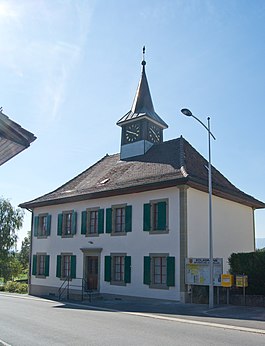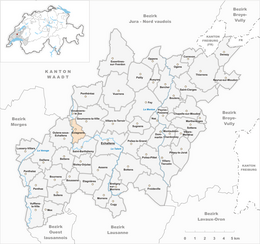Eclagnens
| Éclagnens | ||
|---|---|---|
| Former municipality of Switzerland | ||

Éclagnens village administration building
|
||
|
||
| Coordinates: 46°39′N 6°35′E / 46.650°N 6.583°ECoordinates: 46°39′N 6°35′E / 46.650°N 6.583°E | ||
| Country | Switzerland | |
| Canton | Vaud | |
| District | Gros-de-Vaud | |
| Area | ||
| • Total | 2.14 km2 (0.83 sq mi) | |
| Elevation | 593 m (1,946 ft) | |
| Population | ||
| • Total | 113 | |
| • Density | 53/km2 (140/sq mi) | |
| Postal code | 1376 | |
| SFOS number | 5519 | |
| Surrounded by | Goumoens-la-Ville, Goumoens-le-Jux, Oulens-sous-Échallens, Saint-Barthélemy | |
| Website | Profile (French), SFSO statistics |
|
Éclagnens is a former municipality in the district of Gros-de-Vaud in the canton of Vaud in Switzerland.
The municipalities of Éclagnens, Goumoens-la-Ville and Goumoens-le-Jux merged on 1 July 2011 into the new municipality of Goumoëns.
Éclagnens is first mentioned in 1265 as de Clanens.
Éclagnens has an area, as of 2009[update], of 2.14 square kilometers (0.83 sq mi). Of this area, 1.67 km2 (0.64 sq mi) or 78.0% is used for agricultural purposes, while 0.31 km2 (0.12 sq mi) or 14.5% is forested. Of the rest of the land, 0.12 km2 (30 acres) or 5.6% is settled (buildings or roads).
Of the built up area, housing and buildings made up 2.3% and transportation infrastructure made up 2.8%. Out of the forested land, all of the forested land area is covered with heavy forests. Of the agricultural land, 66.8% is used for growing crops and 10.7% is pastures.
The municipality was part of the Échallens District until it was dissolved on 31 August 2006, and Éclagnens became part of the new district of Gros-de-Vaud.
The municipality is located in the middle of the Gros-de-Vaud region.
The blazon of the municipal coat of arms is Gules, bordered Or, two Bars (or Sea-daces) addorsed of the second.
Éclagnens has a population (as of 2009[update]) of 113. As of 2008[update], 6.0% of the population are resident foreign nationals. Over the last 10 years (1999–2009 ) the population has changed at a rate of 82.3%. It has changed at a rate of 77.4% due to migration and at a rate of 6.5% due to births and deaths. All of the population (as of 2000[update]) speaks French.
...
Wikipedia



